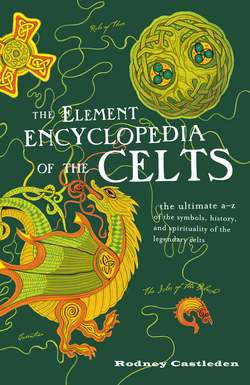Читать книгу The Element Encyclopedia of the Celts - Rodney Castleden - Страница 15
TWO KINDS OF IRON AGE CELTS
ОглавлениеIn 500 BC, there were two communities of Celts, the central European Celts and the Atlantic Celts, leading parallel lives. How much contact was there between the two?
The arrival in Britain of distinct artistic styles that can be related to the styles prevailing in central Europe shows that there was contact. The similarities of style are so strong that they formed the basis of the idea of migration. Now it is thought more likely that only small numbers of people were on the move, perhaps traders and a small number of migrants, yet these movements were enough to take stylistic ideas from one area to the other.
The western Celts interacted with successive European cultures: the Hallstatt, La Tène, and Belgic cultures within the Iron Age, then the Roman civilization, and then the cultures of the Jutes, Angles, Saxons, and Vikings. On the Atlantic fringe, sometimes the culture of the western Celts spread far and wide, making a continuously identifiable Atlantic culture. On occasions this culture was continuous with the central European culture, so that a very extensive culture area was formed. At other times it shrank to relatively small pockets, cells, or refuges.
The waxing and waning of other cultures have sometimes inhibited the development of Celtic culture; at other times they have stimulated it. There was a long period of stasis and conservatism in Europe in the Bronze Age. Much of what happened was a response to the more dynamic and aggressive cultures of south-eastern Europe. In Anatolia (modern Turkey) there was the great Hittite Empire, and adjacent to that were the thriving Minoan and Mycenaean civilizations of the Aegean region. In about 1200 BC the Hittite Empire collapsed. The Minoan civilization was already weakened and subsumed by the Mycenaean civilization, then that too collapsed. Whether these collapses were to do with fundamental inherent weaknesses—time-bombs embedded within the cultures—or were precipitated by invasions or raids from outside, perhaps by the mysterious Sea Peoples, archeologists continue to debate. What is certain is that the pace of cultural development in Europe was suddenly no longer wholly governed from its south-eastern threshold.
The collapse of the Hittite Empire meant that the secrets of ironworking, which had until then been a Hittite monopoly, spread across Europe. The “barbarians” of Europe learned a new technology, which involved beating bronze into thin sheets that could be made into cups, shields, and helmets. They also acquired a taste for wine, which led to an opening of trade routes south to the Mediterranean so that wine could be acquired. Finally, the opening of contact between northern and southern Europe led to a fruitful interchange of ideas between the two regions.
The Bronze Age Europeans who underwent these major changes were the Urnfielders: the people who were the central European (Iron Age) Celts’ immediate precursors.
Even within the Iron Age, what happened in central Europe was affected by what was happening in, and to, Greece. In 540 BC the Phocaean Greeks were in conflict with Carthage, and the two forces fought for supremacy in the western Mediterranean region in a sea battle off the Italian coast. The Carthaginians won and blockaded Greek trade in the Mediterranean. This in turn meant that the Celtic communities developing north of the Alps were cut off from Greek goods, and therefore from Greek models and standards. Those trading relationships were not recovered for 50 years. When they were, developments in Iron Age Celtic culture had taken it elsewhere. A new and more advanced Celtic culture was evolving, the La Tène culture, with a focus on the Rhône and middle Marne valleys.
Later, in the first century BC, came the major inhibiting force of Rome, as the Roman Empire spread northward and westward into the territories of the Celts, conquering, subduing, and Romanizing.
